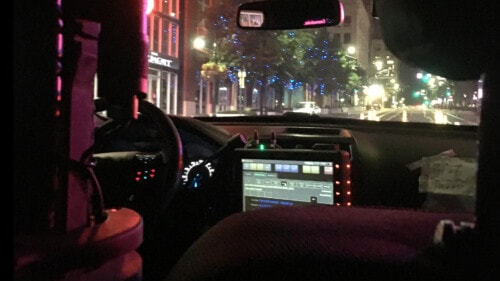Emergency Calls: What Do Kansas Citians Ask of Police? New Data Holds Some Answers
Published July 29th, 2021 at 6:00 AM
Above image credit: A police line do not cross tape. (File photo)“911. What’s your emergency?”
The familiar reply of a 911 operator has become synonymous with the current state of public safety.
A new program at the Kansas City Police Department is capturing more granular data about how often residents summon officers, and why.
Here’s a taste of what happened during nearly 29,000 such calls for service in June:
- The sound of gunfire caused Kansas Citians to call police nearly 700 times.
- Domestic violence prompted 519 requests for assistance.
- And 422 callers wanted police to check on someone who they thought was suicidal.
In general, police are good at generating raw data. The more difficult task lies in how that data is interpreted and how it affects department staffing, leadership’s approach to crime and whether the expectations of the public are being met.
Interactive Calls for Service Slideshow
(Source: Kansas City Police Department. Graphic: Marissa Plescia | Flatland)
Those issues are at the heart of an ongoing debate about Kansas City Police Department funding, the potential value of local control and how best to combat violence on the city’s streets.
“The misperception is that people think that those within the community are anti-law enforcement,” said Branden A. Mims, chief operating officer of the Ad Hoc Group Against Crime. “They are not. … They just want them to serve them better.”
But the community’s trust in the police has been eroded by fatal police shootings of Black men and other uses of force that people find excessive, Mims said.
Ad Hoc is among a broad coalition of organizations supporting a request to the U.S. Department of Justice to investigate the Kansas City Police Department for civil rights violations. The effort, announced Monday, is led by the Urban League of Greater Kansas City, along with other civil rights and community groups.
Proponents say mining calls for service data for insights can help inform the debate about the KCPD, which have intensified to include demands for Chief of Police Rick Smith to resign.
The police department’s system, recently posted online, is interactive, allowing anyone to dig into the data. The calls for service database reveals both the types of calls, as well as the location. The department cautions, however, that it is continuing to refine the program.
During June, the month for which information is currently available, the data offered specifics about the 28,817 requests for help that KCPD received in the top five priority categories.
During the month, the East patrol division generated the most calls in the city. It was followed by Central and Metro patrols. The two patrol divisions in the Northland had the fewest calls.
Where Help is Needed
(Source: Kansas City Police Department. Graphic: Marissa Plescia | Flatland)
Some law enforcement experts say that calls for service can be a more effective way to help determine police staffing and department priorities than some other longstanding methods. In the past, those decisions were often shaped by available funding, per capita formulas aligned with population or assumptions that simply adding more officers would reduce crime.
That’s not necessarily the best approach, studies show. Moreover, restoring trust in police, along with reducing violence, increasingly is the goal of police, civic and community leaders.
At the conclusion of Tuesday’s Kansas City Board of Police Commissioners meeting, Mayor Quinton Lucas said he was pleased that much of the focus had been on new ways of approaching crime and police/community relations.
“Much of today’s meeting was about transitions,” Lucas said. “Are we going to do things the same way?”
Budget Battle
A lawsuit filed by the Board of Police Commissioners is challenging the Kansas City Council’s recent vote to shift about $42 million (about one-fifth) of the police budget toward programs that would specifically target crime prevention, community outreach and engagement.

The council approved the plan in a swiftly passed measure in May, drawing immediate pushback from the department’s leadership and other members of the Board of Police Commissioners. Lucas is a member of the state-appointed board.
A court hearing is set for Sept. 1.
Whatever the outcome, efforts to align the department’s staffing with community needs and crime trends will likely retake center stage.
“There’s a lot of folk dying and ain’t nobody getting arrested for it,” said longtime community advocate Keith Brown. “How do we deal with these violent problems in our community and what is the role of police?”
Brown once led anti-crime initiatives in Kansas City and also has been a part of recent protests against the police for use of force that resulted in the deaths of Black men.
“Those who are most affected by violence, they welcome the police. You want them to protect, to help you,” Brown said. But if people are victims of police brutality, he said, “or if their loved ones are, or if they feel they are being bullied, then no.”
Death and injury caused by gunfire is a major concern for police and the community. Armed events were 5.73%, or 1,652, of the calls for service in June.
Noting growing concern over gunfire and violent crime, Jackson County Prosecutor Jean Peters Baker recently asked police to focus more on drug crimes with an apparent link to violence, and limit how many cases they send her office for low level drug crimes.
Baker, in an interview this week on KCUR’s “Up to Date,” said that police and other criminal justice workers have long been told that drugs equal violence. But an analysis of local prosecution data showed that isn’t as true as once believed.
“There’s an intolerable ineffectiveness to us continuing to enforce this war on drugs,” Baker said.
Indeed, drug crimes do not appear to account for a high percentage of calls police receive, at least based on calls for service data. Buying, selling or using drugs was just 0.37% of all calls in June.
The category of “emotionally disturbed person” also was a smaller fraction of police work than some conversations about mental health and policing might imply, just 3.18% of calls. Nearly half of those calls involved checking on a person believed to be suicidal.
Even so, criminologists caution that data without context can only offer so much insight.
For instance, outcomes such as whether a criminal act occurred or whether an arrest was made are not captured in the information now available online, noted Richard Rosenfeld, curators’ distinguished professor emeritus with the Department of Criminology and Criminal Justice at the University of Missouri-St. Louis.
Rosenfeld previously debunked a familiar narrative that arose after the protests following the death of Michael Brown in August 2014 in Ferguson, Missouri. Brown was shot by an officer.
The so-called “Ferguson effect” was based on a fear that criticism of police had caused homicides to spike in 2015.
“We found no evidence for a ‘Ferguson effect’ linking police killings of Black citizens to the homicide spike via de-policing,” according to a report co-authored by Rosenfeld.
Similar predictions are forming around the current efforts in Kansas City and elsewhere to shift some police funding more toward preventative crime measures.
In a statement that criticized Kansas City’s efforts to shift some police funding, Missouri Attorney General Eric Schmitt cautioned: “Attempts to defund the police will deprive Kansas City residents of a needed police presence and exacerbate homicide and violent crime rates plaguing Kansas City and major cities across Missouri and the country.”
Rosenfeld is now tracking crime statistics for the Council on Criminal Justice. He is methodically gauging evidence of such cause and effect theories through the data available in dozens of cities nationwide.
The most recent report, “Pandemic, Social Unrest and Crime in U.S. Cities,” was released in May 2021. It noted an alarming rise in homicides in 2020.
The report offered this conclusion: “as the pandemic subsides, long lasting reductions in violence and crime will require cities to adopt evidence-based crime-control strategies and long-needed reforms to policing.”
Data like what Kansas City is now compiling could be vital for those discussions.
Baker, in a presentation before the Board of Police Commissioners meeting Tuesday on drug cases and racial disparities, said that she is hyper focused on “longstanding vulnerable communities,” which tend to be those most impacted by violent crime.
“These are the people that I’m really looking at, speaking to and looking to find ways to do a better job representing and gaining their trust, gaining their legitimacy by policies that actually work for them and that are actually fair.”
Flatland contributor Mary Sanchez is a Kansas City-based writer and a nationally syndicated columnist with Tribune Content Agency.




